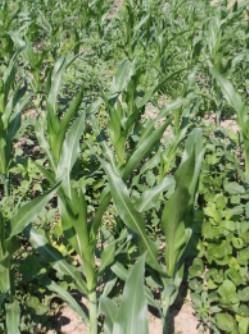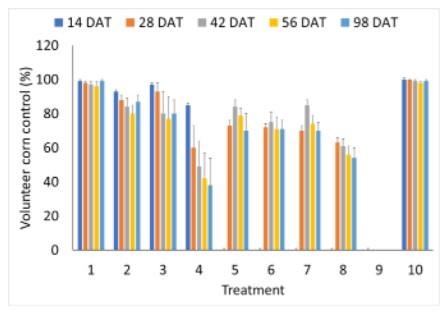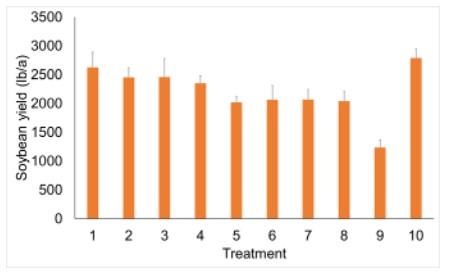By Vipan Kumar and Rui Liu
Recent development of Enlist corn allows the use of 2,4-D choline (Enlist One), glyphosate (Roundup PowerMax), glufosinate (Liberty), and aryloxyphenoxypropio-nate (FOPs) herbicides for controlling grass and broadleaf weeds. However, volunteer Enlist corn plants can cause infestation in subsequent Enlist E3 soybean (resistant to 2,4-D, glyphosate, and glufosinate) in areas where a corn-soybean rotation is commonly practiced.

Figure 1. Volunteer Enlist corn plants competing with Enlist E3 soybean at Agricultural Research Center in Hays.
A research study in 2020 at the Agricultural Research Center-Hays tested the effectiveness of Select Max and Poast Plus alone or in tank-mixtures with Enlist One. Treatments were applied either as an early postemergence (8- to 12-inch tall corn), or late postemergence (12- to 30-inch tall corn).
Results indicated that Select Max applied early postemergence alone provided an excellent, season-long control (95 to 99%) and highest biomass reduction (up to 100%) of volunteer Enlist corn in Enlist E3 soybean. However, volunteer corn control was significantly reduced when Enlist One was tank-mixed with Poast Plus.
Volunteer corn control was low to moderate (50–85%) with all late postemergence programs tested. Soybean grain yield did not differ among early postemergence treatments (39 to 44 bu/a), while grain yield was significantly lower (about 34 bu/a) for late postemergence treatments.
These results suggested that the early postemergence application of Select Max and Poast Plus can effectively control volunteer Enlist corn infestation in Enlist E3 soybean. However, tank-mixing Enlist One with Poast Plus could compromise the efficacy of Poast Plus.
Table 1. List of herbicide treatments tested
Treatments | Herbicide program | Rate (fl oz/a) | Timing |
1 | Select Max* | 16 | Early Post |
2 | Poast Plus** | 24 | Early Post |
3 | Select Max* + Enlist One | 16 + 32 | Early Post |
4 | Poast Plus** + Enlist One | 24 + 32 | Early Post |
5 | Select Max* | 16 | Late Post |
6 | Poast Plus ** | 24 | Late Post |
7 | Select Max* + Enlist One | 16 + 32 | Late Post |
8 | Poast Plus** + Enlist One | 24 + 32 | Late Post |
9 | Nontreated | -- | -- |
10 | Hand weeded | -- | -- |
* Nonionic surfactant at 0.25% v/v was included |
** Crop oil at 1% v/v and ammonium sulfate (AMS) at 2% wt/v was included |

Figure 2. Effect of herbicide treatments on volunteer Enlist corn control in Enlist E3 soybean at 14, 28, 42, 56, and 98 days after treatment (DAT).

Figure 3. Effect of herbicide treatments on Enlist E3 soybean grain yield.
Source : ksu.edu